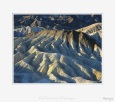
Death Valley is a valley in the U.S. states of California and Nevada, and is the location of the lowest elevation in North America at 282 ft (86 m) below sea level. It is one of many places on land which fall below mean sea level. Located southeast of the Sierra Nevada range in the Great Basin and the Mojave Desert, it constitutes much of Death Valley National Park. It runs north-south between the Amargosa Range to the east and the Panamint Range to the west; the Sylvania Mountains and the Owlshead Mountains form its northern and southern boundaries, respectively. It has an area of about 3,000 square miles.
 Death Valley is considered one of the best examples of the
Basin and Range configuration. It lies at the southern end of a geological
trough known as the Walker Lane which runs north into Oregon. The
valley is bisected by a right lateral strike slip fault, the Death
Valley Fault. The eastern end of the left lateral Garlock Fault intersects
the Death Valley Fault. Located on the border of California and Nevada,
Death Valley is the principal feature of the Mojave and Colorado Deserts
Biosphere Reserve. Death valley also contains salt pans. Millions
of years ago, there was an inland sea located over where Death Valley
is today, but as the area turned to desert, the water evaporated,
leaving behind the salt.
Death Valley is considered one of the best examples of the
Basin and Range configuration. It lies at the southern end of a geological
trough known as the Walker Lane which runs north into Oregon. The
valley is bisected by a right lateral strike slip fault, the Death
Valley Fault. The eastern end of the left lateral Garlock Fault intersects
the Death Valley Fault. Located on the border of California and Nevada,
Death Valley is the principal feature of the Mojave and Colorado Deserts
Biosphere Reserve. Death valley also contains salt pans. Millions
of years ago, there was an inland sea located over where Death Valley
is today, but as the area turned to desert, the water evaporated,
leaving behind the salt.
Temperatures in the Valley can range from up to 130 °F (54 °C) in the day in the summer, to below freezing at night in the winter. The lowest temperature on record at Furnace Creek Inn is 15 °F (-9 °C). The National Climatic Center reports that temperatures at Furnace Creek reach 90 °F (32 °C) on an average of 189.3 days annually and 100 °F (38 °C) on an average of 138.0 days annually. Freezing temperatures occur on an average of 11.7 days each year.
Death Valley is home to the Timbisha tribe, who have inhabited the valley for at least the past 1000 years. Some families still live in the valley at Furnace Creek. The name of the valley, tümpisa, means 'rock paint' and refers to the valley as a source of red ochre paint. Another village in the valley was located in Grapevine Canyon near the present site of Scotty's Castle. It was called maahunu in the Timbisha language, the meaning of which is uncertain although hunu means 'canyon'. (Source Wikipedia)
© 1998-2025 - C. Cassegrain Photograph - All rights reserved v.01 - Mobile : +33 6 71 26 04 76 |